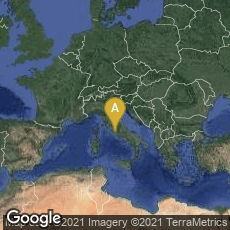

Leaf 5 from one of two digital editions of this work from the Bayerische StaatsBibliothek. The book began with an elaborate listing of contents, showing the order in which the various locations were described in the book. This listing, which was called an index, was closer to a Table of Contents in the modern sense, except that it did not refer to specific pages since the printed edition was neither paginated nor foliated.
Between 1444 and 1446 humanist and historian Flavio Biondo (Flavius Blondus) of Rome wrote and published Roma instaurata, the first systematic and well documented guide book to the ruins of ancient Rome, or any other ancient ruins, launching the new archaeology of the Renaissance.
". . . Roma instaurata launched a new archaeology. No one before Biondo had attempted so comprehensive and through a survey of ancient Rome nor tried to explain so much nor did it so acutely. Digressions are by no means rare in Biondo's treatise and some of them are really short dissertations on some antiquarian point. His section on the 'Velabrum', for instance, strives to explain this rather obscure name. This he starts to do by rejecting the medieval corruption 'velum aureum', whence he passes on to examine and discuss the evidence offered by Varro, Ovid, Livy, Tacitus and the inscriptions still left in the locality. The whereabouts of the 'Aerarium' gave him an excuse for a historical dissertation on Roman coinage, mainly drawn from the Elder Pliny. Naturally enough Biondo relied constantly upon the ancient writers, but this did not mean that he accepted them invariably as infallible witnesses. Thus when faced with a statement of Cassiodorus that Pompey had been the first builder of theatres in Rome, he set against it one of Pliny, sayiing that the first had been Marcus Scaurus, while against another remark of Cassiodorus, attributing to the Emperor Titus the building of the first amphitheatre in Rome, he set a passage of Tacitus, showing that this was not so.
"Altogether, with the Roma instaurata, it was now possible to have a reasonable idea of ancient Rome, not only from a topographical standpoint, but also as far as its growth and the functions of its buildings were concerned. Here, in this work, the historian reveals himself side by side with the archaeologist, the student of ancient institutions with the humanist who has the classics at his fingertips, though without the help of the Teubner series and Pauly-Wissowa's encyclopaedia" (Weiss, The Renaissance Discovery of Classical Antiquity [1969] 69-70).
Roma instaurata was first published in print with additions by Franciscus Barbarus, Porcellius, and Petrus Oddus Montopolitanus, and a second title, De Romana locutione, in Rome by the "Printer of Statius," before 26 July 1471. The city in which it was printed, the unidentified printer, and the date of the first edition were all inferred by bibliographers. The edition was printed in Roman type that appears in only one other known book, an undated edition of Statius, Thebais et Achilleis. The date is based on a purchase note in the Bibliothèque nationale de France copy dated August 6, 1471, and a contemporary marginal note in the Cambridge copy stating that Pope Paul II was currently reigning (making the date prior to the Pope's death on July 26).
ISTC No. ib00701000. In August 2020 a digital facsimile was available from the Bayerisches Staatsbibliothek at this link. The second edition was published in Verona by Boninus de Boninis, de Ragusia, 1481-82.